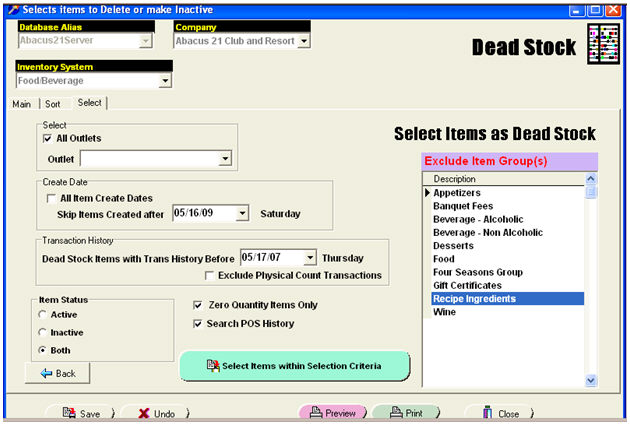

This section describes the considerations associated with 'housekeeping' of Inventory Items -- that is, cleaning up "Dead Stock".
The idea is that Items converted from other systems (or Abacus 21's Legacy System) -- or through time have become "dead" -- should be consider for eradication from the system... as they are no longer needed -- and are merely cluttering the system and inhibiting its performance.
It makes sense to focus on these Items first because they will be the easiest to eliminate without affecting 'active' Inventory Items.
When selecting Items into the Dead-Stock, an audit takes place... searching out POS transactions, Item History transactions, active Purchase Orders, Requisitions, Adjustments, Physical Count Batches, On-Hand Quantities, as well as Recipes and POS Menus. Only those Items that do not have any visible activity will be flagged to be deleted. It is a pretty safe bet that these are a slam-dunk dead stock, so they will be deleted -- not flagged (later version), but actually deleted.
The Dead-Stock program should be run one Outlet at a time -- as trying to select all the Dead-Stock Items in an Inventory System may simply overwhelm the PC's ability to process/display that many Items. By proceeding cautiously and making safe assumptions, the program can be used to pare down the Inventory until it gets to a manageable size, and then involve the Inventory Management staff in determining further Items to make inactive.

This requires the program DeadStock.exe -- and you will need to change the filter for skipping Items created after a selected Date.
Extreme caution should be used when using this program.
Consult Abacus 21 if you have questions.
Note: Item 'deleted' with the Dead-Stock program are "eradicated" from the Datafile... not just 'flagged as deleted' (and available to be re-instated.
The program will not delete any Item that has activity. It is important to note that the program is a two-step process: first, selecting and auditing each Item for activity. After auditing, the User can view/print the audit results, as well as unflag Items that he/she may wish to retain (simply un-check the delete box next to the displayed Item).
It is not until the Save button is pressed (step 2) that the actual deletion takes place; the program makes every effort to show what's happening 'up front' prior to anything's being deleted.
There really isn't a way programmatically that we can differentiate between a 'good' Item that has been created vs. a 'bad' Item that has been created.
Both Items will not have any activity against them, but, in the case of those Items created using the Purchasing Import, we have the good fortune of their being on a P/O, which will exclude them from being flagged for deletion.
When run, the Dead-Stock program automatically skips Items created within the last 30 days.
To override this feature, the 'skip items created after' Date needs to be changed prior to selecting the Items for deletion.
Note: You do not need to have Users be out of the System in order to use the Dead-Stock program.